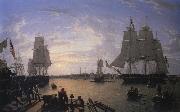Wholesale Oil Painting No Minimum |
|||||||||||
|
|
|||||||||||

|
|||||||||||
|
|
|
||||||||
Robert Salmon1775-1844 American painter of English origin. Having trained and painted in England and Scotland, he moved to Boston in 1828, painting in a 'little hut' near the wharves of South Boston. Reportedly an eccentric, he became a successful painter of marine views, adopting a range of different scales, including small wooden panels, larger canvases and theatre backdrops. Moonlight Coastal Scene (1836; St Louis, MO, A. Mus.) is typical of his works on panel, and it demonstrates his use of light to silhouette form. There are no extant examples of the panoramic views done as backdrops; his canvases such as Wharves of Boston (1829; Boston, MA, Old State House) and View of Charlestown (1833; Annapolis, MD, US Naval Acad. Mus.) are full of carefully delineated figures, minute and accurate details of the ships and their rigging, and, most importantly, large expanses of sky dominated by strong light. Salmon's portrayal of light-filled water and sky, increasingly luminous in the late 1830s and early 1840s, has caused him to be considered by some as the father of LUMINISM (i). He used a low viewpoint and contrasted a distant shoreline and small-scale figures in the foreground in a manner that prefigured the work of Fitz Hugh Lane and Martin Johnson Heade, both of whom were influenced by Salmon's manipulation of scale, light and subject-matter. It appears that he returned to England before his death. |
||||||||
|
|
||||||||
The Boston Harbor from Constitution Wharf
The Boston Harbor from Constitution Wharf Painting ID:: 32011 |
mk77
1833
Oil on canvas
26 3/4x40 3/4in
mk77 1833 Oil on canvas 26 3/4x40 3/4in |
|||||||
|
CONTACT US |

